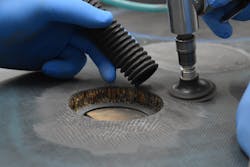Composites are everywhere on today's aircraft and enter new areas as the technology grows. At its most basic, a composite material is one that’s made from two components that when put together result in a stronger material than when separate.
“In aerospace specifically, we usually use fiber materials, advanced fiber materials, mixed with some form of matrix, which are typically polymers. And by doing that, we reinforce the polymer with the strength of these fibers, which otherwise would be supple in nature. And so therefore the matrix provides the shape of the part and the fiber reinforcement provides the strength of the part,” explained Max Thouin, VP sales and business development, Aerodine Composites.
On the military side of aviation, composites have for many years made up a large portion of the aircraft, but now the commercial side of aviation is also seeing an increase, as Louis Dorworth, direct services manager, Abaris Training explains.
“With the advent of new technology, aircraft like the 787, now you’re talking fuselage, wings, full-blown aircraft structures, empennage sections, tails, horizontals, all of that. So you find composites all over an aircraft in today’s aircraft. That medium generation aircraft from the original 737 to maybe Boeing 737 and A320 to what we have today with the 777 and the 787 aircraft from Boeing. And even the A350 from Airbus, they’re very composite intensive aircraft,” Dorworth said, noting that in general aviation, some aircraft are now made of mostly composite materials.
One of the driving factors behind composites increasing usage is that technological advances are allowing for composite material to enter areas of the aircraft where before they would have been destroyed if utilized. For example, ceramic composites are now being used in aircraft engines thanks to their ability to withstand high heat.
“Newer engines such as the one seen on the A320neo and on the 737 MAX, you will see guide veins that are made from ceramic composites. So in this case, we will use a ceramic fiber and a ceramic matrix together to make a very efficient and highly thermally stable and highly thermally resistant composite, which helps lighten the weight of the plane while delivering the same performance as a metallic airplane,” explained Thouin.
“Ceramics can take a lot more heat than plastics, basically,” added Dorworth. “So when you’re trying to put something into an engine and hold tight tolerances like you are with fan blades and such, where you want the most efficient thrust, the thing that you want to have is a material that doesn’t have a very high thermal expansion coefficient. It can handle the temperatures and it can also survive that environment.”
But the guarantee that comes with more composite-based aircraft is more composite damage.
Common Composite Damage
Where a composite is located on an aircraft is going to dictate what kind of damage it’s most likely to be exposed to. But that said, with the overwhelming majority of composite material being located in the fuselage and structural components of an aircraft, it’s impact damage that makes up the majority of damage a technician is likely to see. This is often a result of a collision.
“I’d say the main one is often impact damage, which we affectionately call hangar rash, or ground impact. So, something where either the landing gear did not come out and you bang the airplane onto the runway or even impacts with some of the vehicles that are around the hangar. That happens very, very commonly,” said Thouin.
Dorworth said that the kind of material damaged also makes a difference.
“We classify damage, but to what kind of structure? If the structure is made with a solid laminate or a monocoque laminate, meaning that it’s all one thick laminate like it is in the 787 fuselage. If it’s a big, thick laminate that can carry a lot of load at a much lighter prospect than say a frame metal equivalent, the type of damage that we see in those structures is usually high energy, wide area, impact damage.
“When you have big composites like that, it’s much like the difference between an aluminum aircraft where... Like if it’s an aluminum can, if you bump into it, you’re likely to leave a big dent. With composites, it’s like a big water bottle where you squeeze it and it bounces back. So the damage might be done, but the ability to see it may not be (there). So it would be a barely visible impact damage. It falls into that category,” Dorworth said.
Barely visible damage is one of the challenging aspects of identifying a composite in need of repair. Often, a material can show little to no signs of having been damaged. For example, Dorworth says lighting strikes can leave only a small trace behind.
“Lightning strikes can go internal in some of these panels and all you see is a small little hole on the outside. So, where the energy comes from one end to the other, it could be running just inside the panel along the core line or something like that and come out somewhere else. And the damage is internal to that panel rather than external. So, it’s hard to detect,” he said.
Debonding is another risk with composite materials that Thouin says happens from time to time.
"With a composite to composite structure, a composite metal structure, a composite to honeycomb, the adhesive sometimes fails," he said. "You get fatigue damage... Although composites are extremely strong in fatigue, over time there can become some micro cracking into the laminate due to the high cycles of either it is on skims or it could be in different areas that are very dynamic on the aircraft.”
The other types of damage Thouin said to watch for are stress cracking and erosion.
For repairing composite material there are two main types of repairs: cocure and voltage.
“A cocure repair is typical for a skin that can be scarfed. And what we mean by scarfed is, there’s a damage area which will be completely removed and then there’s a tapering area in the surrounding which you do very gradually, and then you go place, essentially, what you could consider a patch back onto that area by respecting the same gradient that you scarfed to. That’s typically done using heat and vacuum,” Thouin said.
Voltage repairs are typical for a thick laminate that cannot be scarfed.
“So we would essentially, just as is stated, bolt a new skin or both a new part onto the existing part. But I think it’s important to notice that all repairs start out with the guidance of the designer, the OEM, whoever is responsible for that aircraft. And that’s known as the structural repair manual,” Thouin said.
Dorworth said common mistakes are not removing enough of the damage and bonding materials together that aren't compatible.
“For instance, honeycomb core has what we call a pronounced ribbon direction, and you have to match the original ribbon direction with the core. So sometimes you’ll get technicians that don’t match that properly or they’re 90 degrees off on that core replacement. The other part is that people, after they do the scarf repair, sometimes that part, they’ll do slight damage in the structure and just assume that they can cover that up with a repair patch and nobody will know,” he continued.
A Future of Growth
With aircraft becoming more and more composite-based, both Thouin and Dorworth agreed that the adoption rate of composites is going to grow over the coming years, but neither think there will ever be a 100 percent composite aircraft.
“I think adoption will continue to increase. It will forever be a multi-material solution. I don’t think we’ll ever come to a point where we have an airplane that’s run 100 percent composites because there are still some applications where metals are either more efficient or either more performant or sometimes just more efficient to put together. So yes, I think we’re going to continue to see adoption throughout the next decade,” Thouin said.
“The Boeing 777 has a wing box, portions of the fuselage, those sorts of things. 787 included. So we’re seeing that. Over in Europe, the A350 has a fuselage wing, empennage sections. They’re all composites. So they’re going to composites in a big way in the future here. So whether we see all composite or not, I think that’s going to be probably not. We’re going to see a lot of mixed materials, where it’s more efficient to have a titanium fitting or titanium product or an aluminum product. That’s what we’re going to see, is a combination of materials. But the bulk of the structure and the ability to lightweight is found in composites,” added Dorworth.
About the Author
Walker Jaroch
Editor
Contact: Walker Jaroch
Editor | AMT
+1-920-568-8399
>> To download the AviationPros media kits, visit: Marketing Resource Center
>>Check out our aviation magazines: Ground Support Worldwide | Airport Business | Aircraft Maintenance Technology

